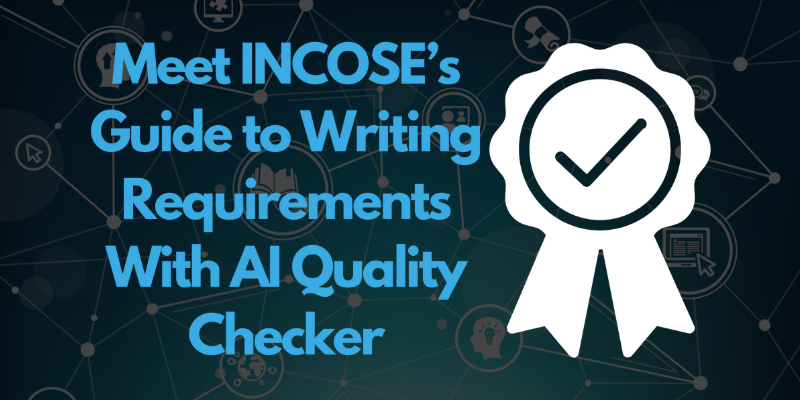AI Tools to Support Requirements Engineering & Test Case Developments
OVERVIEW At SPEC Innovations, Artificial Intelligence technology has evolved the process of requirements engineering and test case generation....

Writing good requirements is essential for the success of any project. Clear, concise, and well-defined requirements set the foundation for a project's scope, deliverables, and success criteria.
This blog explores valuable tips and examples to help you master the art of writing good requirements based on insights from years of experience in project management. If you are brand new to writing requirements, check out our comprehensive guide to requirements management.

One of the key tips to writing great requirements is understanding your stakeholders. By identifying and involving all relevant stakeholders from the beginning, you can ensure that their needs and expectations are captured in the requirements. This collaborative approach leads to more comprehensive and accurate requirements.
There is a huge difference between want and need. One way to establish the difference is by asking yourself if the system will work without that requirement. Rather than focusing on possible solutions, simply list what the system needs - the solution can come later.
The Concept of Operations (CONOPS) is a valuable artifact. The CONOPS will be something that all the stakeholders understand and collaborate on together. Create different scenarios and needs. From there, you will better understand where to start with your requirements.
The CONOPS will help you write quality requirements by finding all the assumptions. It will help evaluate the ‘what if’ scenarios, make testing easier, and formulate your needs into the requirements.
Writing specific requirements is crucial to avoid ambiguity and misinterpretation. However, it is also important not to be overly specific, as this can limit flexibility and creativity in finding solutions. Finding the right balance between specificity and flexibility is key to writing effective requirements.
Understand what is needed and create requirements from those needs. This is why knowing your stakeholders is so important. If you understand your stakeholders' needs, writing requirements rather than instructions becomes an easier task.
Requirements should provide enough information to allow the builder to provide the most cost-effective solution to the problem.
Each requirement should be uniquely identified with a number and name for easy reference and tracking. Additionally, a clear and concise description of the requirement is essential to ensure that all stakeholders have a common understanding of what is being requested.
Traceability is vital in requirements management to establish relationships between requirements, design, implementation, and testing. A requirement that refers to the name of another entity may be related to that entity with a "traced to,“ "satisfied by," or "verified by" relation, as appropriate.
By tracing requirements throughout the project lifecycle, you can ensure that each requirement is satisfied and verified, leading to a successful project outcome.
A rationale justifies the inclusion of a specific requirement. Attach a rationale for each requirement by explaining the need for the requirement. The rationale provides reviewers and implementers with additional information on the intent of the requirements and avoids confusion down the line.
Maintaining proper grammar in requirement documentation is crucial for clarity and consistency. Using proper grammar will prevent costly mistakes due to confusion.
Some grammar mistakes that can cause confusion are:
By following established standards, you can enhance the quality of your requirements and facilitate communication among team members. It never hurts to use a tool like Grammarly. Grammarly works within your browser, so you can even use it with Innoslate.
Use a standard to ensure consistency while writing your requirements, choosing one that is right for your industry.
Common standards are:
SPEC Innovations offers a library of curated standards parsed and ready to be imported into Innoslate. Check out the Digital Curation Station.
Let's consider an example of applying these tips in practice. Imagine you are tasked with developing a new mobile application. A well-written requirement for this project could be:
By following the tips outlined above, this requirement is specific, traceable, and adheres to proper grammar and standards, setting a solid foundation for the project.
Writing good requirements is a skill that can significantly impact the success of a project. By understanding stakeholders, being specific yet flexible, including essential details, ensuring traceability, and following proper grammar and standards, you can enhance the quality of your requirements.
Incorporating these tips and examples into your requirement writing process will help you deliver successful projects that meet stakeholder expectations and objectives.
Have questions about model-based systems engineering or requirements management? Talk to an expert and see how Innoslate can streamline your projects from start to finish.

OVERVIEW At SPEC Innovations, Artificial Intelligence technology has evolved the process of requirements engineering and test case generation....

Tracking and meeting requirements is necessary for any successful project in systems engineering and requirements management. This is where a...

2 min read
Don't feel like reading? Watch the webinar recording instead! In systems engineering and project management, the importance of clear and precise...